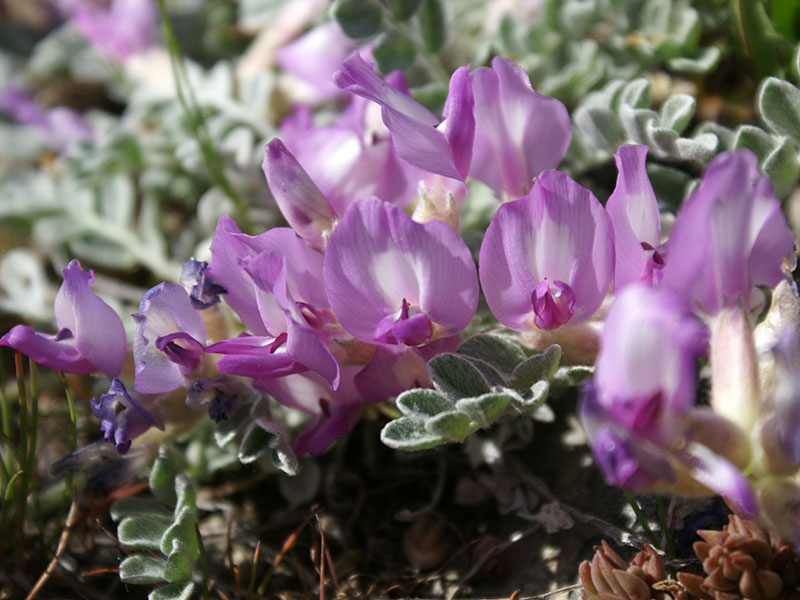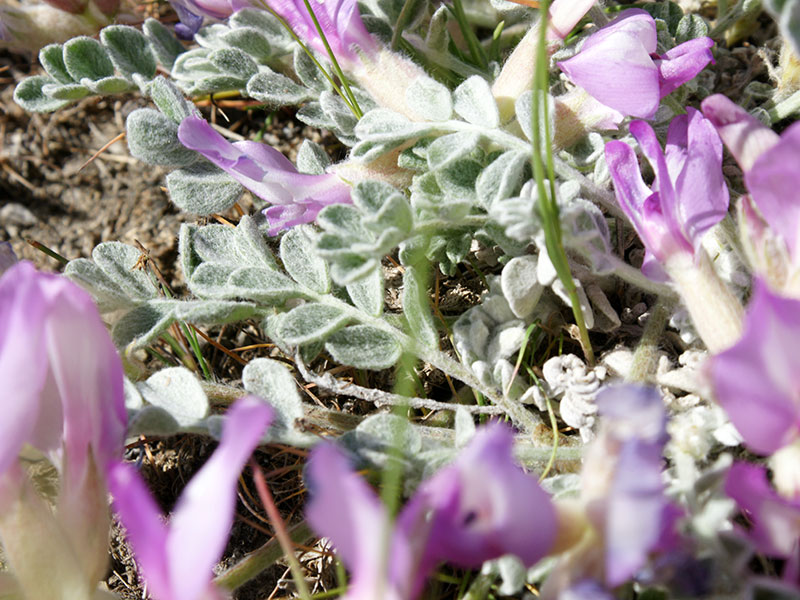Astragalus purshii / woollypod milkvetch
- low growing, silvery, compound leaves; no tendrils
- magenta (or white) “pea-like” flowers with darker keel petal
- “congested” inflorescence
- found in very dry areas, not in shade
Also known as: Pursh’s milkvetch, rattlepod, locoweed, woolypod locoweed
Woollypod milkvetch is a shade intolerant perennial adapted to xerophytic (very dry) conditions. With that, you might see it on the driest parts of your hikes, probably high. The photos here were taken along the ridge atop Henderson Canyon. I don’t think there are all that many true xerophytes in the Valley, so that makes this one special. And, it is pretty.
The plants themselves are caespitose. I only use that word because it looks so weird, but it means low growing. The stems are hairy and “tufted” and rarely stand tall than about 4 inches. The basal leaves have seven to 15 leaflets and are woolly, too, so the plant looks silvery grey. It grows each year from a branched caudex. There are other legumes that look somewhat like the milkvetches, but one feature distinguishing this from Vicia spp. (for example) is that the latter have tendrils.
The flowers of the woollypod milkvetch are on a raceme and vary from whitish to yellowish to reddish-purple in some individuals. Flowers with magenta petals and those with white-ish petals are considered different varieties. The raceme is tightly congested, i.e. without much internode between the flowers. Each inflorescence may have 3 to 10 flowers, and they stand about as tall as the leaves. Another useful characteristic for identification is that the keel petal, the one at the bottom, is darker than the rest… and the banner petal, the large one that looks like a reflector antenna, is slightly reflexed (bending backwards). At least in the Valley, the real details of the flowers will probably not be needed to make the identification.
The fruit itself is a leguminous pod (like a pea pod) that is also densely woolly-hairy, basically looking like a cotton ball. At this state, the stem with the fruit lies flat on the ground.
Interesting bits: One of the common names for woollypod milkvetch is locoweed. It isn’t the only plant with that common name, but it is appropriate. Animals that feast on the plant more than a little can become aggressive and run around with an odd gait. They may run into objects with their heads low, and finally, if the poisoning is really severe, keel over dead. Those that don’t die seldom recover completely. But on the other hand, woollypod locoweed is a preferred food for sage grouse; they eat both the leaves and seeds.
Although it isn’t completely clear what the causative agent for the craziness is, locoweed is a selenium hyperaccumulator. In high concentrations, selenium is toxic.
As a plant for restoration projects or simply as a member of a dry low-nutrient ecosystem, woollypod milkvetch brings nitrogen fixation to the party. Like other legumes, it is nodulated, hosting bacteroids that fertilize it and other plants in its environs.
| Color | |
|---|---|
| Family | |
| Blossom size | |
| Inflorescence size | |
| Inflorescence type | |
| When? | |
| Where? |


